How To Build AI Software: 7 Steps Every Founder Must Know in 2025
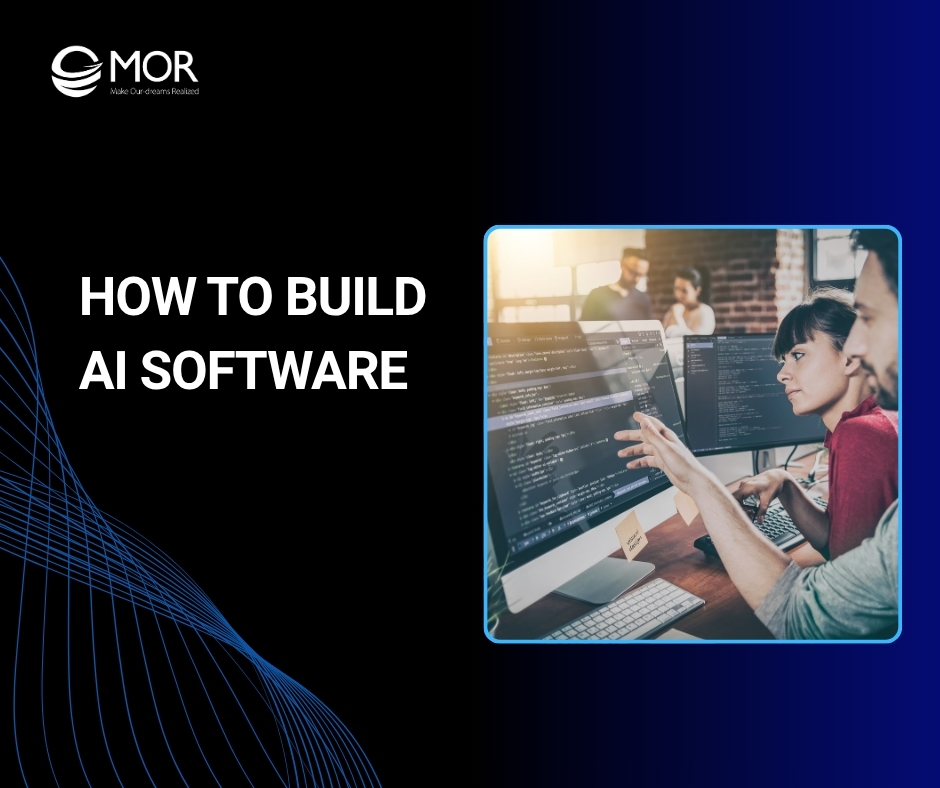
Knowing how to build AI software is key to turning ideas into impactful solutions. MOR Software has outlined the core steps to design, train, and deploy AI effectively. Follow this guide to build, launch, and refine your AI products that deliver lasting value.
Why Is AI Software Worth Investing In For Your Business?
There are three strong reasons why founders and software product companies should explore how to build AI software today.
- Delivers higher value to users: AI-driven features solve problems faster and with greater precision, giving customers a better experience.
- Keeps you competitive: As industries adopt AI at scale, staying ahead requires embracing intelligent solutions.
- Drives stronger profits: Smarter operations and personalized products often translate into higher revenue.
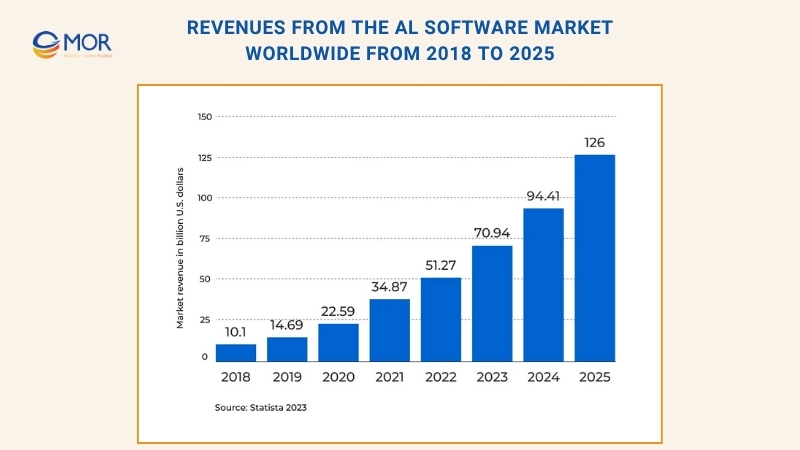
Numbers back this up. Accenture projects AI could double the economic growth rate of some developed nations by 2035. The global AI software market is also on track to hit $126 billion by 2025. Between 2024 and 2030, adoption is forecast to grow at a CAGR of 36.6%.
From a practical angle, machine learning algorithms handle massive datasets with speed and accuracy that humans cannot match. AI-powered chatbots can manage customer queries 24/7, freeing staff for more complex work. Businesses already rely on AI to track buying patterns, forecast demand, and run automated marketing.
Given these outcomes, learning how to build an AI software and partnering with skilled developers is a smart investment for any startup aiming to secure a real edge.
How To Build AI Software: 7 Core Steps You Should Know
Understanding how to build AI software follows a similar path to traditional software development, but there are extra steps unique to AI projects. Each stage requires clear goals, the right tools, and careful execution.
Below are the 7 fundamental steps on how to build software with AI from the ground up:
- Define the problem: Be specific about what you want AI to achieve and how it will add value.
- Collect relevant data: Gather datasets that directly relate to the problem you are solving.
- Clean and organize the dataset: Remove errors, fill gaps, and format the data for model training.
- Select AI tools and techniques: Choose the right machine learning models, libraries, and frameworks for the job.
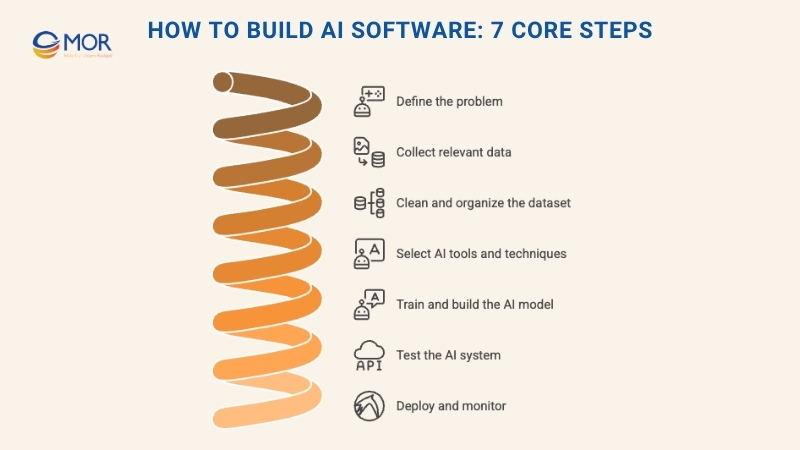
- Train and build the AI model: Develop your model using the prepared data, adjusting parameters for accuracy.
- Test the AI system: Run controlled experiments to evaluate performance and identify improvements.
- Deploy and monitor: Launch the AI software into its intended environment and track results over time.
These steps focus on AI-specific development activities. For guidance on broader stages like product discovery, UX/UI design, or QA processes, explore our related resources packed with practical advice.
Step 1 – Define The Problem You’re Solving
The first step in how to build AI software is to clearly define the problem your solution will address. This is not just about coming up with a creative idea, it’s about understanding the challenge in depth and identifying where AI can provide measurable value.
A well-defined problem shapes every decision in the development process. It will guide your choice of AI technology, whether that’s machine learning for predictions, natural language processing for text understanding, or computer vision for image analysis.
Start by analyzing the pain points of your target audience or business process. Gather feedback, observe workflows, and document where inefficiencies or opportunities exist. Be specific about the outcome you want to achieve and the constraints you’ll face.
The goal is to bridge the gap between a problem and a viable AI-powered solution. Once you’ve pinpointed the issue and how AI can solve it, the rest of the development journey becomes far more focused and effective.
Step 2 – Collect Relevant Data
Once the problem is defined, the next stage in how to build AI software is gathering the right data.
There’s truth in the saying that an AI model can only be as strong as the data it learns from. In this case, ‘right data’ means information that is directly tied to your problem, broad enough to represent all scenarios, and as free from bias as possible.
Data generally falls into two main categories:
- Structured data: Organized, clearly defined, and easy to search. A spreadsheet listing names, addresses, and phone numbers is a simple example. This type of data is straightforward to work with in AI models.
- Unstructured data: Complex and harder to organize. A customer service call transcript is a good example. It contains useful details but lacks a set format. Natural language, varied sentence styles, and idiomatic phrases make it more challenging to process directly.
In AI projects, unstructured data is the most common. Before it can power a model, it usually needs extensive preparation and cleaning to make it usable. Investing time in this stage is essential for building a reliable AI system.
Structured Vs Unstructured Data
Industry | Structured Data | Unstructured Data |
| E-commerce | • Product identifiers• Pricing information | • Patterns in customer behavior and spending• Customer feedback (reviews, social media posts) |
| Healthcare | • Patient records• Medical insurance details• Billing information | • Medical imaging (X-rays, MRI scans)• Physician treatment notes and recommendations |
| Banking | • Transaction histories• Customer account information | • Call logs and web activity• Audio and video communications |
Step 3 – Clean And Organize Your Dataset
The third stage in how to build AI software is cleaning and preparing your data for model training. This step ensures the dataset is accurate, structured, and ready for AI algorithms to process effectively. It typically involves:
- Organizing the data so it follows a consistent structure.
- Removing incomplete or inaccurate entries that could skew results.
- Classifying data to make it more suitable for AI training.
Once the data is cleaned, it’s uploaded for training. Be prepared for an important reality: every time you add or edit data, the AI model will need retraining. This cycle of training and retraining is an ongoing part of AI development services and can be time-consuming.
Gathering data is not just about quantity. It’s about balancing quantity, quality, and structure, then preparing it carefully for effective training.
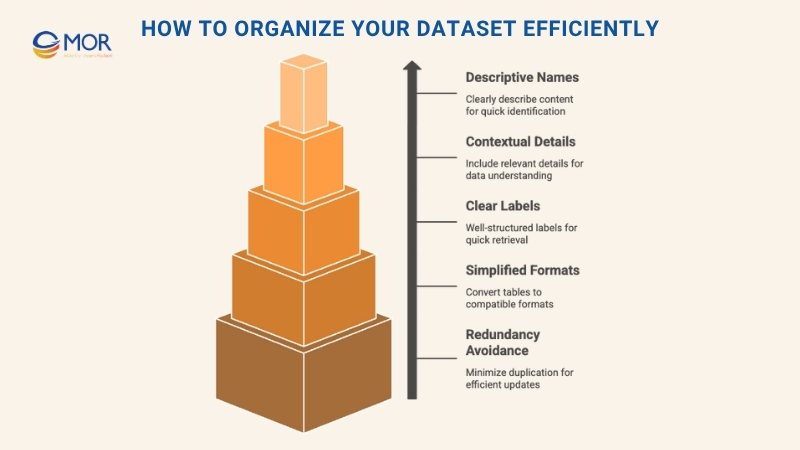
Pro tips for organizing data efficiently:
- Use descriptive file names: Choose names that clearly describe the content for quick identification.
- Add context to files: Include relevant details so the model understands the data’s meaning and use.
- Label data clearly: Well-structured labels help AI systems retrieve the right information quickly.
- Simplify table formats: Convert Word tables into formats like Markdown, JSON, or XML for better compatibility.
- Avoid redundant entries: Minimize duplication to save time when updating data.
Step 4 – Choose The Right AI Tools And Techniques
After preparing your dataset, the next step in how to build AI software is selecting the AI technology that best fits your project. Your choice should match the problem you’re addressing, the data you’ve gathered, and the performance goals you’ve set.
Some of the most common options include:
- Machine learning for tasks like pattern detection, prediction, and decision-making based on large datasets.
- Speech recognition to convert spoken language into text for transcription or voice-command applications.
- Natural language processing (NLP) to understand how does AI work, interpret, and generate human language.
- Computer vision to analyze and extract insights from images and video.
- Augmented reality to integrate interactive digital content with the physical environment.
If you’re working with niche requirements, explore specialized AI tools or frameworks designed for your industry. Open-source platforms, proprietary APIs, and cloud-based AI services can all offer valuable resources.
Choosing the right technology early helps streamline development, avoid costly pivots, and ensure the AI solution can be scaled or integrated with other systems in the future. Once you’ve decided, you can move forward to model development with a clear technical direction.
Step 5 – Train And Build The AI Model
With your AI technology selected, the next stage in how to build AI software is building and training the model using your prepared dataset. This step can be complex, as it involves configuring algorithms, tuning parameters, and ensuring the model learns to deliver accurate results.
The good news is that you don’t always need to code from scratch. No-code AI platforms make it possible to train models by simply uploading your data, allowing the platform to handle the heavy lifting.
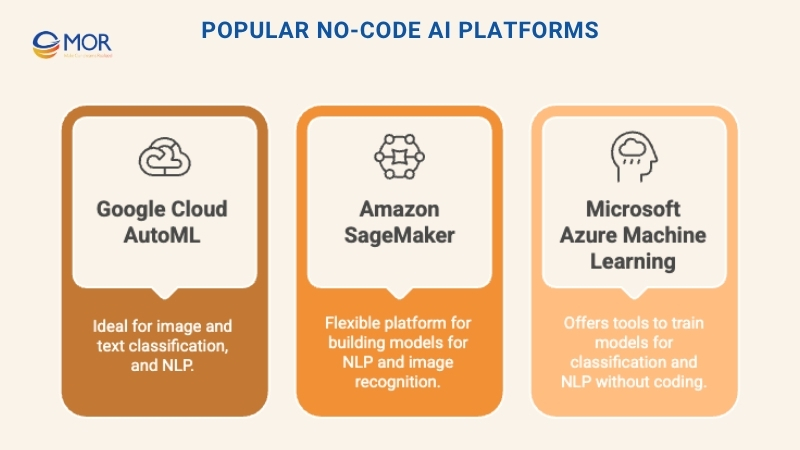
Popular no-code AI software builder include:
- Google Cloud AutoML – Ideal for image classification, text classification, and natural language processing (NLP).
- Amazon SageMaker – A flexible platform for building models for NLP, image recognition, and other AI tasks.
- Microsoft Azure Machine Learning – Offers tools to train models for classification and NLP without coding.
If you prefer more control without traditional coding, visual programming environments let you create AI workflows by dragging and dropping functional blocks. These systems can integrate with third-party tools, APIs, and cloud services to expand capabilities.
Whichever approach you choose, focus on iterative training. Continuously evaluate results, adjust configurations, and feed the model updated, relevant data to improve its accuracy and performance over time.
Step 6 – Run Real Tests And Fine-Tune
Once your model is trained, the next step in how to build AI software is thorough testing to confirm it performs accurately, reliably, and consistently under real-world conditions.
Testing should go beyond basic functionality checks. Evaluate the model’s outputs for accuracy, relevance, and consistency. Look for potential biases, edge cases, and performance gaps. Use an iterative approach, test, analyze results, make adjustments, and repeat until the model meets your quality standards.
Common fine-tuning methods include adjusting training parameters, refining prompts, optimizing algorithms, and expanding or improving the dataset. For complex projects, you may also experiment with different model architectures or integrate additional tools to enhance performance.
This stage is also the right time to assess efficiency and scalability. Monitor processing speed, resource consumption, and cost-effectiveness. If performance is lagging or expenses are too high, consider optimizing infrastructure or adopting cloud services that allow on-demand resource usage.
The ultimate goal is to ensure your AI software not only works as intended but also provides consistent value to end users before it’s released into production.
Step 7 – Release And Monitor The Software
The last stage in how to build AI software is releasing your model into a live production environment where it can deliver value to real users. This step transforms months of research, design, and testing into a working solution that addresses the problem you set out to solve.
Prepare for deployment
At this point, ensure your model is properly packaged, your infrastructure is secure, and your environment is configured for optimal performance. Implement CI/CD pipelines to streamline releases and reduce downtime.
Launch with stability in mind
Consider a gradual rollout, such as canary deployments or feature flags, to monitor performance on a smaller scale before expanding to all users. This approach reduces the risk of widespread issues and gives you time to fix unexpected bugs.
Establish monitoring and feedback loops
Once live, track key performance metrics like accuracy, latency, and error rates. Set up alert systems for any anomalies and gather direct user feedback to identify improvement areas.
Plan for continuous improvement
AI models can degrade over time due to changes in data or user behavior. Regularly update and retrain your model with fresh data to keep it relevant and effective.
Common Challenges When Building AI Software
AI can transform software development, but it brings its own set of obstacles. From technical limitations to ethical concerns, here are some of the most frequent issues teams face when figuring out how to build AI software.
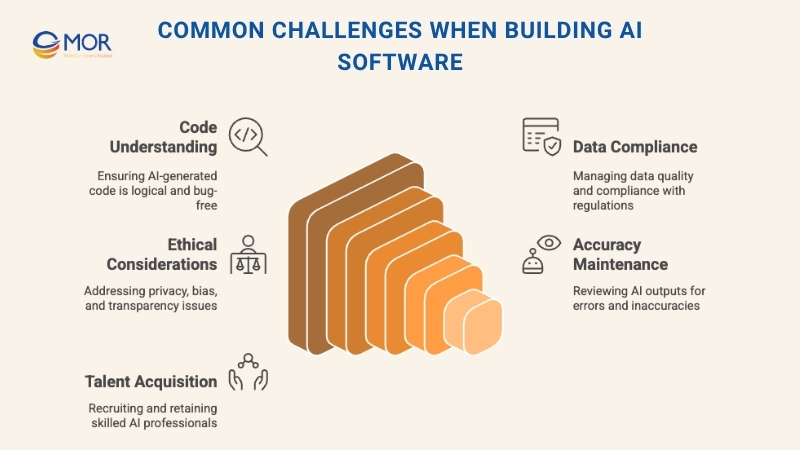
Understanding And Writing Code
AI can generate code, but it doesn’t always grasp the full logic behind it. This can lead to bugs, security gaps, and trouble when scaling or adapting the solution in the future.
Data Compliance And Quality
Accenture’s Compliance Risk Study found that 54% of organizations rely on AI or ML to improve compliance. Yet, these same tools can cause disruption if data governance isn’t handled well. In any industry, AI projects demand high-quality, compliant data that meets regulations for accessibility, security, and accuracy.
Ethical And Legal Considerations
AI diversity in sectors like healthcare, finance, or any product that processes personal data introduces privacy, bias, transparency, and accountability concerns. Every deployment must account for these factors to avoid long-term risks.
This is why integrating AI building code compliance software can help ensure privacy, transparency, and adherence to industry laws
Inaccuracies And Errors
Even the most advanced AI can produce flawed or misleading results. Human review remains critical to catch mistakes and maintain trust.
Talent Acquisition And Retention
The demand for skilled AI professionals is high. Recruiting and keeping specialists who can manage complex AI systems is a major challenge for many businesses.
MOR Software provides tailored Generative AI automation services for industries like fintech, healthcare and more. Whether you need one expert or a full team of backend, frontend, QA, design, and product management professionals, we can support every stage of your AI product build.
AI Software Development: MOR Software’s Tips
Drawing from real-world experience building AI products, we’ve gathered practical lessons to help you succeed when learning how to build AI software.
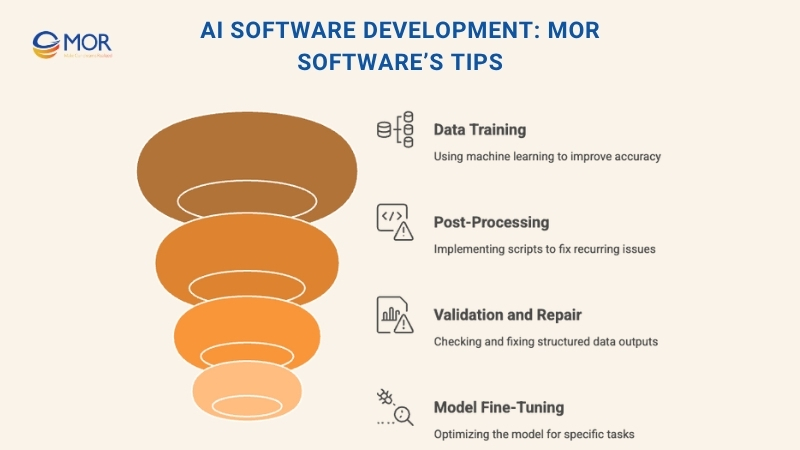
Tip 1: Use Machine Learning To Train Your System
Machine learning enables AI solutions to learn and adapt over time, improving accuracy and performance with continued use. Start with clean, well-structured data, because if the input is flawed, the output will be too.
Make sure your training data is relevant, diverse, and reflects real-world scenarios to avoid bias. As your AI interacts with users, retraining it with updated data will keep it accurate and effective.
Tip 2: Create Post-Processing Scripts
Implement scripts to automatically fix recurring issues in your AI’s output. For example, code-based models can benefit from scripts that detect and correct problems like unbalanced braces or missing quotation marks. This extra layer of refinement can significantly improve the reliability of your software.
Tip 3: Validate And Repair
When your AI outputs structured data like JSON, use validation libraries available in most programming languages to check its accuracy. If issues are detected, apply automated repair methods whenever possible.
For cases where the output can’t be fixed, have a fallback process, this could mean re-running the model or returning a safe default or error message to the user.
Tip 4: Fine-Tune Your Model
If your AI regularly generates JSON or similar structured outputs, consider fine-tuning it for that specific task. A targeted training process can significantly improve the model’s ability to produce valid, accurate results, reducing errors and improving consistency.
3 Unique AI Software Development Ideas Worth Exploring
Before answering the question how to build AI software, it’s worth asking what kind of AI solution you should create. Finding the right idea can be just as challenging as building the product itself. To spark inspiration, here are three non-generic AI app concepts with strong market potential.
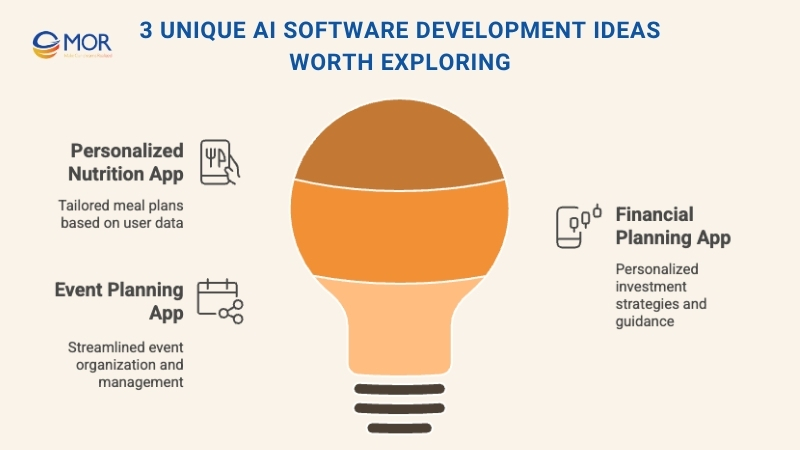
Ai-Powered Personalized Nutrition App
Nutrition varies from person to person, and AI can make it even more tailored. An intelligent nutrition app could gather data about a user’s health, habits, and preferences, then generate a customized meal plan that meets their specific nutritional requirements.
Ai-Powered Financial Planning And Investment App
The fintech sector remains highly attractive. By integrating machine learning, an app could deliver personalized investment strategies and financial guidance. Experian reports that 67% of Gen Z and 62% of U.S. millennials already use AI for tasks like budgeting and improving credit scores.
Ai-Powered Event Planning App
Event organization can be stressful, but AI can streamline the process. A smart planning app could recommend venues, caterers, and suppliers based on budget and style, while also helping with schedules, invitations, and RSVP tracking.
What’s Coming Next For AI Software Development?
Artificial intelligence is already reshaping how we live and work, and its influence will only grow stronger in the years ahead.
Grand View Research projects the global AI market to expand at a 37.3% growth rate between 2023 and 2030, reaching a value of $1,811 billion. Healthcare and finance are expected to lead adoption, driving significant innovation in both sectors.
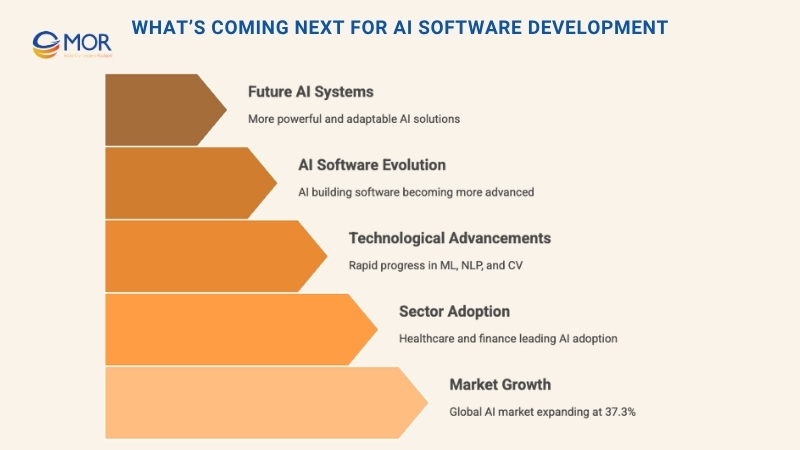
Advancements in machine learning, natural language processing, and computer vision are moving at an exceptional pace. As these technologies mature, AI building software will become more advanced, enabling solutions that address increasingly complex challenges.
The future points toward AI systems that are not only more powerful but also more adaptable and capable of delivering highly specialized results across industries.
Let Your AI Development Journey Be Easier With MOR Software
Building AI software can feel overwhelming, data prep, model training, tech decisions, constant iterations. We’ve seen businesses stall not because they lack ideas, but because they lack the right team to execute.
That’s where MOR Software comes in. We work with companies across industries to turn early-stage AI ideas into working products. Whether you need fully custom AI solutions or help integrating off-the-shelf AI tools, our team handles the messy parts so you don’t have to.
- Full-cycle support: From discovery to deployment, we cover every stage of AI software development.
- Tech that fits: We recommend the right AI tools based on your goals, not just trends.
- Cross-functional teams: Get access to engineers, designers, QA, and product managers who’ve done this before.
- Faster go-to-market: Our agile process helps you launch, test, and iterate quickly.
- Reliable infrastructure: We build secure, scalable AI systems with long-term performance in mind.
If you’re looking AI automation agencies to simplify your AI journey and actually ship. MOR Software is ready to help. Contact us right now!
Conclusion
Mastering how to build AI software requires solving the right problem, using quality data, and selecting the right technology. You can create AI solutions that deliver real value and adapt over time by following these steps to build AI software carefully. At MOR Software, we help businesses design, develop, and maintain AI products that perform reliably in the real world. If you’re ready to bring your AI vision to life, contact us today.
MOR SOFTWARE
Frequently Asked Questions (FAQs)
How to build an AI developer?
Becoming an AI developer starts with a solid foundation in computer science or a related field. You’ll need to master programming languages like Python, study data structures and algorithms, and understand statistics. From there, explore machine learning, deep learning, and AI frameworks. Hands-on projects and real-world experience are key to building strong expertise.
Can I build an AI without coding?
Yes. Modern no-code platforms let you build functional AI applications, like chatbots or recommendation systems, without writing any code. These tools are great for beginners or businesses with limited technical resources.
How much does it cost to build an AI software?
The cost of developing AI software depends on the system’s complexity. A basic AI solution typically ranges from $20,000 to $30,000, while more advanced applications can exceed $40,000 or more, especially when involving custom features or deep learning components.
How are AI programs created?
Creating an AI program involves identifying a clear problem, gathering and preparing relevant data, selecting appropriate algorithms, training models, testing for accuracy, and deploying the final product. The process also includes ongoing monitoring and optimization to maintain performance.
What software is used to build AI?
Tools like PyTorch and TensorFlow are commonly used for building AI applications. These platforms support deep learning, offer strong community support, and integrate with a range of libraries and tools that help developers design, train, and optimize AI models.
Can I create my own AI?
Yes, it's possible to build your own AI using no-code tools like Lindy.ai, which lets users create personalized AI assistants without writing any code. You can start with templates or build something from scratch depending on your goals.
Is it hard to build AI software?
Yes, quite. Building AI software can be challenging due to the need for data handling, model training, and system integration. However, with the right tools, knowledge, and team, it’s a manageable process that can lead to powerful, business-ready solutions.
How much did ChatGPT cost to make?
Developing ChatGPT involved significant investment. Estimated costs include $10M–$20M for computational infrastructure, up to $25M for engineering and deployment, and $2M–$5M for compliance and safety. Altogether, the total development cost is estimated between $47M and $115M.
How much does 1 AI cost?
Building a simple AI system may cost around $10,000 to $30,000. For more customized solutions, especially those that involve large datasets or complex functionalities, the cost can increase significantly based on the scope and development needs.
Can I build an AI without coding?
Yes, several platforms now allow users to create AI models without writing any code. These tools provide visual interfaces and templates, making it easier for non-developers to build chatbots, recommendation engines, or image recognition apps.
How to make AI like ChatGPT?
To build an AI like ChatGPT, start by selecting an NLP framework such as NLTK, Spacy, or Gensim. Then train your model on large language datasets, fine-tune it with conversation data, and deploy it using scalable infrastructure that supports real-time interactions.
Can I train my own AI model?
Yes, but it requires access to high-quality datasets, adequate computing resources, and technical knowledge of model design and training processes. It’s a resource-intensive task that benefits from expertise in machine learning and model evaluation.
Can AI write its own software?
AI can generate code snippets, automate repetitive programming tasks, and assist in software development. However, the output still needs human review to ensure logic, accuracy, and maintainability before being used in production.
Can I create my own AI agent?
Yes, building an AI agent has become more accessible with modern tools. Whether you're creating a task-based assistant or a learning agent, platforms like Botpress provide frameworks and tutorials to help users of all skill levels get started.
How was ChatGPT made?
ChatGPT was built using large GPT models that were fine-tuned through supervised learning and reinforcement learning with human feedback (RLHF). Human trainers played a key role in guiding model responses and improving its conversational abilities.
Rate this article
0
over 5.0 based on 0 reviews
Your rating on this news:
Name
*Email
*Write your comment
*Send your comment
1